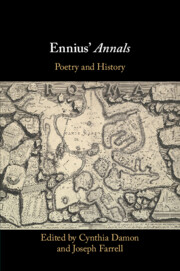74 results
Chapter 11 - Was Memmius a Good King?
- from Part V - Worldviews
-
-
- Book:
- Approaches to Lucretius
- Published online:
- 25 June 2020
- Print publication:
- 16 July 2020, pp 219-240
-
- Chapter
- Export citation
Contents
-
- Book:
- Ennius' <I>Annals</I>
- Published online:
- 10 April 2020
- Print publication:
- 09 April 2020, pp vii-viii
-
- Chapter
- Export citation
III - Influence
-
- Book:
- Ennius' <I>Annals</I>
- Published online:
- 10 April 2020
- Print publication:
- 09 April 2020, pp 167-240
-
- Chapter
- Export citation
II - Authority
-
- Book:
- Ennius' <I>Annals</I>
- Published online:
- 10 April 2020
- Print publication:
- 09 April 2020, pp 89-166
-
- Chapter
- Export citation
Abbreviations
-
- Book:
- Ennius' <I>Annals</I>
- Published online:
- 10 April 2020
- Print publication:
- 09 April 2020, pp xi-xiv
-
- Chapter
- Export citation
Index Locorum
-
- Book:
- Ennius' <I>Annals</I>
- Published online:
- 10 April 2020
- Print publication:
- 09 April 2020, pp 349-352
-
- Chapter
- Export citation
Dedication
-
- Book:
- Ennius' <I>Annals</I>
- Published online:
- 10 April 2020
- Print publication:
- 09 April 2020, pp v-vi
-
- Chapter
- Export citation
Works Cited
-
- Book:
- Ennius' <I>Annals</I>
- Published online:
- 10 April 2020
- Print publication:
- 09 April 2020, pp 310-338
-
- Chapter
- Export citation
Contributors
-
- Book:
- Ennius' <I>Annals</I>
- Published online:
- 10 April 2020
- Print publication:
- 09 April 2020, pp ix-x
-
- Chapter
- Export citation
Chapter 3 - The Gods in Ennius
- from I - Innovation
-
-
- Book:
- Ennius' <I>Annals</I>
- Published online:
- 10 April 2020
- Print publication:
- 09 April 2020, pp 63-88
-
- Chapter
- Export citation
General Index
-
- Book:
- Ennius' <I>Annals</I>
- Published online:
- 10 April 2020
- Print publication:
- 09 April 2020, pp 339-348
-
- Chapter
- Export citation

Ennius' Annals
- Poetry and History
-
- Published online:
- 10 April 2020
- Print publication:
- 09 April 2020
IV - Interpretation
-
- Book:
- Ennius' <I>Annals</I>
- Published online:
- 10 April 2020
- Print publication:
- 09 April 2020, pp 241-295
-
- Chapter
- Export citation
Introduction: History and Poetry in Ennius’ Annals
-
-
- Book:
- Ennius' <I>Annals</I>
- Published online:
- 10 April 2020
- Print publication:
- 09 April 2020, pp 1-22
-
- Chapter
- Export citation
I - Innovation
-
- Book:
- Ennius' <I>Annals</I>
- Published online:
- 10 April 2020
- Print publication:
- 09 April 2020, pp 23-88
-
- Chapter
- Export citation
Copyright page
-
- Book:
- Ennius' <I>Annals</I>
- Published online:
- 10 April 2020
- Print publication:
- 09 April 2020, pp iv-iv
-
- Chapter
- Export citation
17 - Virgil’s Intertextual Personae
- from Part III - Contexts
-
-
- Book:
- The Cambridge Companion to Virgil
- Published online:
- 06 July 2019
- Print publication:
- 18 April 2019, pp 299-325
-
- Chapter
- Export citation
Statistical state dynamics analysis of buoyancy layer formation via the Phillips mechanism in two-dimensional stratified turbulence
-
- Journal:
- Journal of Fluid Mechanics / Volume 864 / 10 April 2019
- Published online by Cambridge University Press:
- 11 February 2019, R3
-
- Article
- Export citation
Statistical state dynamics of vertically sheared horizontal flows in two-dimensional stratified turbulence
-
- Journal:
- Journal of Fluid Mechanics / Volume 854 / 10 November 2018
- Published online by Cambridge University Press:
- 12 September 2018, pp. 544-590
-
- Article
- Export citation
Chapter 9 - Getting to “Giants”
- from Part I - Threads in the Tapestry
-
-
- Book:
- On the Shoulders of Giants
- Published online:
- 12 October 2017
- Print publication:
- 13 October 2017, pp 27-30
-
- Chapter
- Export citation



